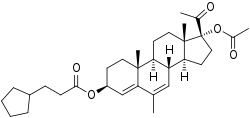Cymegesolate
Cymegesolate (developmental code name Progestin No. 1), also known as cypionyl megestrol acetate or as megestrol acetate 3β-cypionate, is a progestin medication which was never marketed.[1][2][3][4][5][6] It was developed in China in the late 1970s and early to mid 1980s for use as a hormonal contraceptive.[1][2][3][4][5][6] The medication was formulated at a dose of 50–100 mg in combination with a "trace" dose of 0.25–0.5 mg quinestrol as a long-lasting, once-a-month combined oral contraceptive pill.[1][2] This combination has been studied in 1,213 women across a total of 9,651 menstrual cycles, with contraceptive effectiveness of over 99.13% and "very few side effects."[1] At the high dose (100 mg / 0.5 mg), it showed an anovulation rate of only about 60%, and instead mediated its contraceptive effects via a marked anti-implantation effect.[2]
 | |
| Clinical data | |
|---|---|
| Other names | Cypionyl megestrol acetate; Megestrol acetate 3β-cypionate; Megestrol acetate 3β-cyclopentylpropionate; Progestin No. 1; Progestin I; Progestagen I; 17α-Acetoxy-6-dehydro-6-methylprogesterone 3β-cypionate; 17α-Acetoxy-6-methylpregna-4,6-diene-3,20-dione 3β-cypionate |
| Routes of administration | By mouth[1][2] |
| Drug class | Progestin; Progestogen; Progestogen ester |
| Identifiers | |
IUPAC name
| |
| CAS Number | |
| PubChem CID | |
| ChemSpider | |
| Chemical and physical data | |
| Formula | C32H46O5 |
| Molar mass | 510.715 g/mol g·mol−1 |
| 3D model (JSmol) | |
SMILES
| |
InChI
| |
Chemistry
Cymegesolate, also known as megestrol acetate 3β-cypionate, as well as 17α-acetoxy-6-dehydro-6-methylprogesterone 3β-cyclopentylpropionate or 17α-acetoxy-6-methylpregna-4,6-diene-3,20-dione 3β-cyclopentylpropionate, is a synthetic pregnane steroid and a derivative of progesterone and 17α-hydroxyprogesterone.[1][2] It is the C3β cypionate (cyclopentylpropionate) ester of megestrol acetate.[1][2] A closely related medication is acetomepregenol (mepregenol diacetate; also known as megestrol 3β,17α-diacetate), which, in contrast, has been marketed.[7][8][9][10]
References
- De-Wei Z (1982). "Research activities in the field of oral contraceptives in the People's Republic of China". Acta Obstet Gynecol Scand Suppl. 105: 51–60. PMID 6952745.
- Yang, Yi-chien; Gu, Xi-gen; Li, Shu-xiang (1982). Proteins and Steroids in Early Pregnancy. pp. 335–342. doi:10.1007/978-3-642-67890-5_22. ISBN 978-3-642-67892-9.
- Chi-ming, L. (1983). New Long Acting Contraceptive Progestagen Studies on Synthesis of “Cymegesolate”[J]. Reproduction & Contraception, 4, 011.
- Yang YQ, Li SX, Gu XG (August 1985). "[Effect of progestin no. 1 (cymegesolate) on menstrual cycles and plasma levels of progesterone in rhesus monkeys]". Sheng Li Xue Bao (in Chinese). 37 (4): 368–73. PMID 3837333.
- Hui-ling, Y. Y. C. C., & Jin-fen, S. (1982). Key Words: Long-acting Progestogen Contraceptive 3-Cyclopentyl Propionate of Megestrol Acetate (Progestin No. 1), Pharmacology, Rabbits; Pharmacological Study on a Long-Acting Progestogen Contraceptive 3-Cyclopentyl Propionate of Megestrol Acetate (Progestin No. 1)[J]. Reproduction & Contraception, 4.
- Xue-jing, W. J. Z. Y., & Mo-zhen, W. (1983). Clinical Study of a Long-Acting Progestogen Contraceptive 3-Cyclopentyl Propionate of Megestrol Acetate (Progestin No. 1)[J]. Reproduction & Contraception, 2, 009.
- Sidel'nikova VM, Demidova EM, Borisova IuF, Dondukova TM, Absava GI, Korkhov VV (1990). "[The use of acetomepegrenol in the therapy of threatened abortion]". Akusherstvo I Ginekologii︠a︡ (in Russian) (9): 37–40. PMID 2278305.
- Grinenko, G. S.; Popova, E. V.; Korkhov, V. V.; Lesik, E. A.; Petrosyan, M. A.; Topil'skaya, N. I. (March 2000). "Synthesis and biological activity of 17α-acetoxy-3β-phenylpropionyloxy-6-methylpregna-4,6-dien-20-one". Pharmaceutical Chemistry Journal. 34 (3): 113–114. doi:10.1007/BF02524577. ISSN 1573-9031.
Note that 3,17-diacetoxy-6-methylpregna-4,6-dien-20-one (1b), a structural analog of compound 1a, is certified in Russia under the trade name acetomepregnol and recommended for therapeutic purposes in gynecological practice and as a contraceptive preparation in combination with estrogens [4].
- Mashkovskii, M. D. (December 2000). "Eightieth Anniversary of the Drug Chemistry Center/All-Russian Pharmaceutical Chemistry Scientific Research Institute". Pharmaceutical Chemistry Journal. 34 (12): 677–680. doi:10.1023/A:1010416205068. ISSN 1573-9031.
- Sergeev, P. V.; Rzheznikov, V. M.; Korkhov, V. V.; Grinenko, G. S.; Semeikin, A. V.; Mayatskaya, E. E.; Samoilikov, R. V.; Shimanovskii, N. L. (July 2005). "Investigation of the Gestagen Activity of 17α-acetoxy-3β-butanoyloxy-6-methylpregna-4,6-dien-20-one". Pharmaceutical Chemistry Journal. 39 (7): 358–360. doi:10.1007/s11094-005-0154-4. ISSN 1573-9031.
Gestagens are widely used in medicine as drugs for the treatment of breast and uterine tumors, endometriosis, uterine bleeding, and premenstrual syndrome, as a means of hormonal therapy and maintenance of pregnancy, and as contraceptives [1, 2]. In clinics, drugs of this group are represented by acetomepregenol (AMP), medroxyprogesterone acetate (MPA), levonorgestrel, progesterone, didrogesterone, etc. [1].